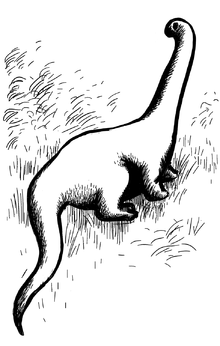Mokele-Mbembe
The Mokele-Mbembe ( Lingála : Mokɛle-mbɛmbe ) is a mythical creature that is said to live in the jungles of Central Africa in the area of the Congo .
For the pygmy tribe of the Bangombe, who live in the Congo Basin around the Tele Lake , its reputation (Mokele-Mbembe - "who stops the flow of the river") is legendary. According to reports and lore of the Pygmies, Mokele-Mbembe is said to have attacked the tribe's fishermen in their light canoes.
description
Mokele-Mbembe is said to be about the size of an elephant, although there have been reports of even larger animals. It is said to be a four-footed creature whose footprints resemble those of hippos ; the feet should each have three claws. It is said to have a long neck with a diameter of about thirty centimeters, a relatively small head, which in male specimens should have a horn or a horn-like extension (as is the case, for example, with some recent reptiles), and a long tail. The creature is said to resemble a sauropod . It is said to be a herbivore , but it attacks people who invade its territory and, if necessary, kills them, but never eats them. The skin color of the Mokele-Mbembe should vary from brownish-gray to reddish-brown.
Expeditions
The first written account of Mokele-Mbembe comes from the French missionary Abbe Liévin Bonaventure Proyart. In his book about travels in the Congo region, published in 1776, he tells of a strange being whose footprints are said to have been one meter in circumference.
The German Ludwig Freiherr von Stein zu Lausnitz was the first foreigner to collect reports on Mokele-Mbembe on an expedition in the Likouala-aux-Herbes river basin in 1913 . The local pygmies showed him a path that the creature is said to have drawn through the jungle.
From 1920 to 1935 there were said to have been several sightings of various eyewitnesses claiming to have seen a creature with a long, snake-like neck, stocky legs and massive body.
In 1954, an English tourist in Lake Bangweul is said to have seen a long neck with a snake-like head protruding from the water, and in the 1960s a big game hunter is said to have seen a large animal come ashore from the water near the Likouala-aux-Herbes river, the description of which applies to Mokele-Mbembe.
From October to December 1980, the German couple Herman and Kia Regusters are said to have heard vocalizations and several mysterious movements of the water caused by a large animal.
In the same year, scientists and cryptozoologists Roy P. Mackal, James Powell, Richard Greenwell and Justin Wilkinson conducted two expeditions to the Congo to investigate reports of Mokele-Mbembe dating back as much as two hundred years. They collected eyewitness reports, legends and myths about the legendary being and came to the conclusion that many of the descriptions were alike.
In 1983 the biologist Marcellin Agnagna claims to have observed several Mokele-Mbembe in Lake Tele for several minutes. However, he was unable to provide evidence such as filming due to an alleged misalignment of his video camera, although the fact that he subsequently changed his reports several times cast doubt on his credibility.
In September 1992, a Japanese research team claims to have filmed an unknown animal swimming in the lake from an airplane. The poor quality video recording, only 15 seconds long, shows a long-necked creature crossing the lake and, according to the Japanese, can be identified as Mokele-Mbembe. What it was, however, could not have been determined; it could also have been a large swimming python.
In 2006 an expedition by cryptozoologists Milt Marcy, Peter Beach and Rob Mullin to the Congo was supposed to bring clarity about the existence or non-existence of the Mokele Mbembe. After their return, however, they could show nothing more than an alleged plaster cast of a Mokele-Mbembe footprint.
Scientific explanations
Since a single animal would die out sooner or later, Mokele-Mbembe would have to be a viable population of these animals. The question arises what the Mokele-Mbembe could actually be.
Some of the eyewitness accounts and legends can certainly be traced back to confusion with known animals. For example, the sighting of Marcellin Agnagna in 1983 could also be traced back to the large African softshell turtle Trionyx triunguis .
Various other recent animal species have been listed by cryptozoologists and zoologists which may have misinterpreted some of the sightings or tracks: e.g. B. with the Nile crocodile , hippos , rhinos or the West African manatee ( Trichechus senegalensis ).
According to another theory, Mokele-Mbembe is said to be a species of dinosaur of the sauropod order that has survived to this day . Sauropods share some basic physical characteristics: a relatively small head, a very long neck, a long tail. All sauropods walked on four sturdy legs and were toe-walkers , similar to today's elephants . Mokele-Mbembe's descriptions allow at least this theoretical interpretation.
The problem is that so far no carcasses, bones or similar relics have been found that would suggest a survival of a sauropod order to the present.
Others
Mokele-Mbembe is also the name of a variant analyzed by Stefan Bücker in the Alekhine defense in chess.
literature
- Redmond O'Hanlon: Congo Fever. German translation from English by Chris Hirte. Eichborn, Frankfurt am Main 1998, ISBN 3-8218-0565-X , (Original edition: Congo Journey. Hamish Hamilton LTD., London 1996, ISBN 0-241-13374-2 ).
- Thomas Thiemeyer: Reptilia. Knaur, Munich, ISBN 3-426-63458-9 .
- Klaus Kunkel: In the swamp of the Mokele-Mamba. Booklet series Das Neue Abenteuer No. 66/1955, Verlag Neues Leben, Berlin 1955.
Web links
Individual evidence
- ^ Liévin Bonaventure Proyart: Histoire de Loango, Kakongo, et autres royaumes d'Afrique. Paris 1776. New edition: Gregg, Farnborough 1968

